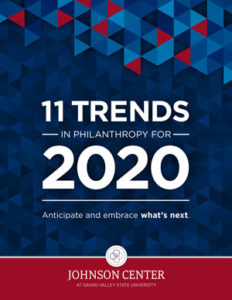Increasing Critiques of (Big) Philanthropy


Authors Michael Moody and Tory Martin take a closer look in this piece from our 11 Trends in Philanthropy for 2020 report.
 Go to any philanthropy conference today and one of the keynote speakers is likely to be the author of a book about “the elite charade of changing the world” (Giridharadas, 2019), “why philanthropy is failing democracy” (Reich, 2018), or the need to “decolonize” and “heal” (Villanueva, 2018) a philanthropic sector gone awry.
Go to any philanthropy conference today and one of the keynote speakers is likely to be the author of a book about “the elite charade of changing the world” (Giridharadas, 2019), “why philanthropy is failing democracy” (Reich, 2018), or the need to “decolonize” and “heal” (Villanueva, 2018) a philanthropic sector gone awry.
The same conversation is happening even outside philanthropy’s circles. Historian Rutger Bregman made headlines for bitterly dismissing the “stupid philanthropy schemes” of the rich at Davos (Ho, 2019), and the public questioned the legitimacy of donor priorities after donations poured in to repair fire-damaged Notre Dame Cathedral (Sullivan, 2019). Mainstream media outlets criticize billionaires like Mark Zuckerberg or Michael Dell when they argue against a wealth tax by defending how much good they can do with their wealth through large-scale philanthropy (Aronoff, 2019; Roberts, 2019).
Some (though definitely not all) of these critiques go beyond arguments on the effectiveness of philanthropic practice. They question whether philanthropy even has a legitimate place in democratic societies, and they challenge the considerable power wielded by big philanthropists. Some critics don’t just say “fix it” but rather, “throw it out.”
Sharp, fundamental, even scathing critique of philanthropy is certainly not new. As Rob Reich (2018) points out, French economist Anne Robert Turgot railed in the mid-1700s against donor-directed, perpetual foundations using arguments that are remarkably similar to the ones we hear now. When Andrew Carnegie and other Gilded Age philanthropists announced their philanthropic plans, they were met with deep suspicion — in the same way George Soros and many other big donors are today.
“Big donors shape the communities we all live in, often in transformative ways. They have outsized impact on every cause we care about.”
This debate is necessary and has clearly been helpful in raising core questions about philanthropy’s role over the years. Any powerful, widespread, value-laden social institution like philanthropy should be subject to close examination and critical appraisal. Big donors shape the communities we all live in, often in transformative ways. They have outsized impact on every cause we care about. And their actions have social and moral implications that we should examine closely (Payton & Moody, 2008).
In fact, thoughtful scrutiny of philanthropy is arguably more essential than ever before, as philanthropy — especially elite philanthropy — is experiencing tremendous expansion and unprecedented evolution (Soskis, 2014). These changes are raising tough questions that we need to talk about. For instance:
Fortunately, our ability to scrutinize activities like elite giving — a world that used to be mostly hidden — is also increasing.
Philanthropy-focused media outlets — from Nonprofit Quarterly to the Chronicle of Philanthropy to Inside Philanthropy — have grown in the last several decades, bringing a journalistic penchant for investigation and constant questioning to their coverage of philanthropy. Many of these outlets have recurring series on topics like “philanthropy and democracy” (Chronicle of Philanthropy, 2019).
And when philanthropy makes it to the proverbial front page of the mainstream media, it is often a story about critiques of giving. In 2000, Felicity Barringer of The New York Times identified “the four horsemen of nonprofit coverage — charity balls, big gifts, soft features about worthy programs and, of course, scandal.” Today, the fourth topic is still a popular focus, and the coverage of the other three often includes questions about their actual impact. This does not mean there is more bad behavior and unaccountable elite control in philanthropy today, just that it is easier now to learn about and debate that behavior and control (Lenkowsky, 2006).
While all this increased scrutiny and critique is, again, essential, we also need to be careful. We need to avoid throwing the baby out with the bathwater.
Some current critiques, for instance, move too easily from concerns about the most elite — or the most egregiously unethical — expressions of philanthropy, to foundational condemnations of the entire institution and practice of philanthropy. They slip too easily from judgments of big philanthropy to judgments of all philanthropy. This simplistic stance threatens to undermine the significant historical and social role philanthropy can, has, and should play in our democracy (Buchanan, 2019).
“[W]e have to have meaningful, open, informed conversations about what we want the role of philanthropy to be, and what philanthropy “at its best” looks like.”
Organized philanthropy, done well, can have a dramatic and even inclusive impact in communities. It can embrace our highest ideals of democratic decision-making and community-shaped responses to collective challenges. But to reach this aspiration, we have to have meaningful, open, informed conversations about what we want the role of philanthropy to be, and what philanthropy “at its best” looks like (National Center for Responsive Philanthropy, 2009).
As this trend toward increasing critique of philanthropy continues, we would hope not for less critique, but for better critique. This means critique that is:
Good critique is a calling in, not a calling out. And in a democratic society, all people should be called in to the conversation about institutions that affect their lives and societies as much as philanthropy does. If this is where the current trend toward greater critique of philanthropy leads us, it will be worth the often difficult debate.


Aronoff, K. (2019, October 21). Mark Zuckerberg’s plea for the billionaire class is deeply anti-democratic. The Guardian. Retrieved from https://www.theguardian.com/commentisfree/2019/oct/21/mark-zuckerberg-plea-biillionaire-class-anti-democratic
Barringer, F. (2000, November 20). Moving beyond the four horsemen of the philanthropy beat. The New York Times. Retrieved from https://archive.nytimes.com/www.nytimes.com/library/national/112000give-barr.html
Buchanan, P. (2019). Giving done right: effective philanthropy and making every dollar count. New York, NY: Public Affairs.
Chronicle of Philanthropy. (2019, December 12). Philanthropy and democracy. [Special report]. Retrieved from https://www.philanthropy.com/specialreport/philanthropy-and-democracy/218
Giridharadas, A. (2019). Winners take all: The elite charade of changing the world. New York, NY: Vintage Books.
Ho, S. (2019, February 12). Bill, Melinda Gates unfazed by criticism of wealthy giving. AP News. Retrieved from https://apnews.com/b1279711ee234b3ab3916d292d262643
Lenkowsky, L. (2006). The politics of doing good: Philanthropic leadership for the twenty-first century. In W. Damon & S. Verducci (Eds.), Taking philanthropy seriously: Beyond noble intentions to responsible giving (pp. 50–61). Bloomington, IN: Indiana University Press.
Madoff, R. D. (2016, October 27). Charities and taxpayers deserve more from donor-advised funds. Chronicle of Philanthropy. Retrieved from https://www.philanthropy.com/article/Opinion-Charities-and/238202
Moody, M. (2019a). The wealth gap is becoming a giving gap. 11 Trends in Philanthropy for 2019 (pp. 15–16). Retrieved from https://johnsoncenter.org/giving-gap
Moody, M. (2019b). Boundaries are blurring between philanthropy and business. 11 Trends in Philanthropy for 2019 (pp. 5–6). Retrieved from https://johnsoncenter.org/boundaries-are-blurring
National Center for Responsive Philanthropy. (2009). Criteria for philanthropy at its best. Washington, DC: Author. Retrieved from https://www.ncrp.org/wp-content/uploads/2016/10/paib-fulldoc_lowres.pdf
National Philanthropic Trust. (2019). The 2019 DAF report. Retrieved from https://www.nptrust.org/reports/daf-report
Ostrower, F. (2016, March 31). Perpetuity or spend-down: does the notion of lifespan matter in organized philanthropy? Nonprofit Quarterly. Retrieved from https://nonprofitquarterly.org/perpetuity-or-spend-down-does-the-notion-of-lifespan-matter-in-organized-philanthropy
Payton, R. L., & Moody, M. P. (2008). Understanding philanthropy: Its meaning and mission. Bloomington, IN: Indiana University Press.
Reich, R. (2018). Just giving: Why philanthropy is failing democracy and how it can do better. Princeton, NJ: Princeton University Press.
Roberts, R. (2019, March 13). Why does everybody suddenly hate billionaires? Because they’ve made it easy. The Washington Post. Retrieved from https://www.washingtonpost.com/lifestyle/style/why-does-everybody-suddenly-hate-billionaires-because-theyve-made-it-easy/2019/03/13/00e39056-3f6a-11e9-a0d3-1210e58a94cf_story.html
Rockefeller Philanthropy Advisors. (2019, September). Social compact in a changing world. Retrieved from https://www.rockpa.org/wp-content/uploads/2019/09/Social-Compact-in-a-Changing-World.pdf
Soskis, B. (2014, May 12). The importance of criticizing philanthropy. The Atlantic. Retrieved from https://www.theatlantic.com/business/archive/2014/05/the-case-for-philanthropy-criticism/361951
Sullivan, P. (2019, April 26). Notre-Dame donation backlash raises debate: what’s worthy of philanthropy? New York Times. Retrieved from https://www.nytimes.com/2019/04/26/your-money/notre-dame-donation-backlash-philanthropy.html
Villanueva, E. (2018). Decolonizing wealth. Oakland, CA: Berrett-Koehler Publishers, Inc.